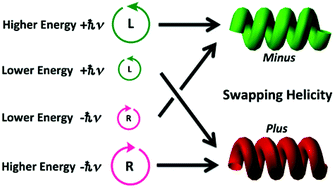Photon magic: chiroptical polarisation, depolarisation, inversion, retention and switching of non-photochromic light-emitting polymers in optofluidic medium†
Abstract
Circularly polarised (CP)-photons at six different energies (six wavelengths) were irradiated to non-photochromic, highly photoluminescent poly[(9,9-di-n-octylfluoren-2,7-diyl)-alt-bithiophene] (PF8T2) as μm-sized particles in chloroform–methanol cosolvents. This approach led to the capability of photophysically controlling all chiroptical polarisation, depolarisation, inversion, retention and switching in the ground and/or photoexcited states, as proven by circular dichroism (CD), optical rotation dispersion (ORD) and circularly polarised luminescence (CPL) spectroscopy. By optofluidically tuning the refractive index of the cosolvents at 589 nm (nD), these CP-photon induced CD signals were resonantly enhanced at a specific nD of ≈1.40. Surprisingly, regardless of the same l- (and r-) CP hand, the choice of higher and lower CP-photon energies led to a swapping of signs in chiroptical polarisation of the particles. The CP-photon hand, l- and r-, was not a deterministic factor for the induced chiroptical sign of the PF8T2 particles. This anomaly originates from CD inversion characteristics between lower and higher energy regions, supported by ZINDO calculations of PF8T2 model oligomers. Finally, controlled CP-photon sense and irradiating energy successfully allowed CPL-silent PF8T2 particles (quantum yield of 15%) to change to CPL-active particles of the order of |gCPL| = (1.9–4.3) × 10−3 at ≈535 nm whilst almost keeping the quantum yield of 8%.


 Please wait while we load your content...
Please wait while we load your content...